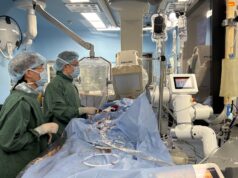 The results of a propensity-matched analysis of all patients undergoing mitral valve surgery or transcatheter edge-to-edge repair (TEER) for severe mitral regurgitation, taken from France’s national administrative hospital discharge database, suggest that TEER was associated with lower cardiovascular mortality than mitral surgery at mid to long-term follow-up.
The results of a propensity-matched analysis of all patients undergoing mitral valve surgery or transcatheter edge-to-edge repair (TEER) for severe mitral regurgitation, taken from France’s national administrative hospital discharge database, suggest that TEER was associated with lower cardiovascular mortality than mitral surgery at mid to long-term follow-up.
Pierre Deharo (CHU Timone, Marseille, France) and colleagues from centres across France detailed their findings in a paper published in the European Heart Journal, having collected information for all consecutive patients treated for mitral regurgitation in France with isolated TEER or isolated mitral valve surgery between 2012 and 2022.
The study period postdates the introduction of the transcatheter MitraClip (Abbott) system in the country, which arrived in late 2010/early 2011, and reflects a “consistent” increase in indications for TEER and the number of patients treated using the therapy, the authors note.
During the 10-year duration of the study, Deharo et al report that a total of 598,036 adults were hospitalised and had a principal, related, or significantly associated diagnosis of mitral regurgitation.
Patients were followed until 30 June 2022 for the occurrence of outcomes, with the study team aiming to evaluate the incidence of all-cause death, cardiovascular death, ischaemic stroke, rehospitalisation for pulmonary oedema, myocardial infarction, major or life-threatening bleeding, new onset of atrial fibrillation, endocarditis, cardiac arrest and pacemaker implantation.
The researchers identified that, over the course of their analysis, 57,030 patients underwent either isolated mitral valve surgery or isolated mitral TEER. In the unmatched patient population, those treated with TEER were typically older, with higher rates of cardiovascular risk factors, vascular disease, chronic kidney disease and percutaneous coronary intervention (PCI) history. Patients undergoing each procedure were propensity-score matched based upon baseline characteristics, with the resulting groups for each treatment comprising 2,160 patients. It is interesting to note that surgery followed a steady number during those 10 year while TEER mean year of inclusion was late 2019 showing the exponential curve of adoption of this technology in France
At three-year follow-up, the study team reports that TEER was associated with a significantly lower incidence of cardiovascular death, pacemaker implantation and stroke, though the incidence of non-cardiovascular death, recurrent pulmonary oedema and cardiac arrest were more frequent after TEER. There were no significant differences observed between the two groups regarding all-cause death, endocarditis, major bleeding, atrial fibrillation and myocardial infarction.
Discussing their findings, Deharo and colleagues write that as in previous reports, the population in their study shows a marked difference in risk factors among those undergoing TEER versus those undergoing surgery.
“Patients undergoing TEER remained typically a sicker population at baseline, and may, therefore, be at increased risk for adverse events,” they write. “In our cohort including all TEER and isolated mitral surgery in France, non-cardiovascular death was significantly more frequent in the TEER group to surgery. This may be related to the more fragile and comorbid patients undergoing TEER and potentially to factors not taken into account in the matching process.”
However, they note, over time the potential improvement in TEER device implantation and physicians’ expertise may have led to a shift in patient characteristics for eligibility, procedural success and ultimately, clinical outcomes.
“Overall, the lower incidence for cardiovascular death following TEER is in favour of the benefit of this treatment in current indications and practices at a nationwide level.” Significant interaction was observed with increased benefit of TEER in patients older than 75 and with a EuroSCORE II score of >4%. Therefore, those patients may particularly benefit from TEER, Deharo and colleagues suggest.
The authors acknowledge several limitations to their work, notably the retrospective, observational nature of the study, and its potential residual confounding factors and biases. Added to this they note that it was not possible to discern primary and secondary severe mitral regurgitation due to the same code used for both in the national database, while the specific surgical technique adopted could not be properly differentiated for each patient.
The findings should be confirmed in ongoing dedicated randomised trials, the authors stress in their concluding remarks.










